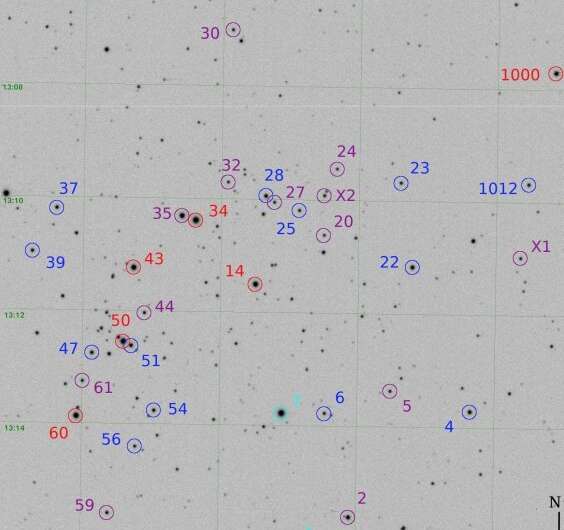September 20, 2019 report
Open cluster NGC 2345 investigated in detail

European astronomers have performed a comprehensive study of the young open cluster NGC 2345. The new research resulted in determining fundamental parameters of dozens of stars in the cluster and also unveiled the presence of new members. The findings are detailed in a paper published September 11 on arXiv.org.
Open clusters, formed from the same giant molecular cloud, are groups of stars loosely gravitationally bound to each other. So far, more than 1,000 of them have been discovered in the Milky Way, and scientists are still looking for more, hoping to find a variety of these stellar groupings. Expanding the list of known galactic open clusters and studying them in detail could be crucial for improving our understanding of the formation and evolution of our galaxy.
Recently, a group of astronomers led by Javier Alonso-Santiago of Catania Observatory in Italy, decided to take a closer look at NGC 2345—one of the known but poorly studied open clusters. It is a young cluster with low metallicity, located most likely some 10,000 light years away within the disc of the Milky Way galaxy. NGC 2345 is known for its relatively high fraction of Be stars, which makes it an interesting target for studying stellar evolution.
The team used various ground-based telescopes to investigate NGC 2345, including the 2.5-meter Isaac Newton Telescope (INT). They obtained spectra for 76 stars and high-resolution spectroscopy for an in-depth analysis of the blue and red evolved stars.
"We performed an in-depth analysis of NGC 2345, the most complete to date. We provided the largest set of spectra, most of them for classification purposes, which combined with photometry and astrometry has allowed us to carry out a consistent analysis," the astronomers wrote in the paper.
The research identified a new red supergiant and 145 new stars of B-type, most likely members of NGC 2345. At least about 10.3 percent of all the likely B-type members were found to be Be stars. The study increased the member of known red supergiants in the cluster to six.
According to the paper, the initial mass of the cluster was calculated to be around 5,200 solar masses. This allowed the researchers to classify NGC 2345 as a moderately massive cluster.
The astronomers also investigated the chemical composition of NGC 2345 by computing the abundances of several chemical elements. They found a homogeneous composition compatible with the Galactic trends observed in the thin disc of the Milky Way.
In concluding remarks, the scientists noted that the results underline the importance of NGC 2345 in terms of improving our understanding of massive and intermediate-mass stars.
"NGC 2345, as it happens with NGC 3105, despite its unusually low metallicity, can be considered an excellent laboratory to improve theoretical models and an optimal template for the study of more obscured or unresolved clusters," the authors of the paper wrote.
More information: J. Alonso-Santiago, et al. A comprehensive study of NGC 2345, a young open cluster with a low metallicity arXiv:1909.04967v1 [astro-ph.GA]: arxiv.org/abs/1909.04967
© 2019 Science X Network




















